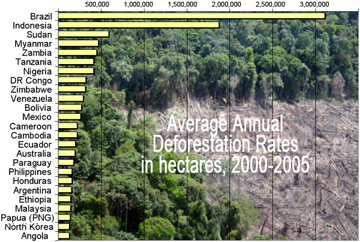Deforestation and REDD Facts & Figures
-----------------
Primary forest loss
The following section is a quantitative look at primary forest loss.
More than seven million hectares of primary forest were lost on an annual basis between 2000 and 2005, the most recent period for which data is available from the U.N. Food and Agriculture Organization. Roughly half this loss occurred in Brazil, which is home to the largest extent of tropical forest in the world: the Amazon.
But FAO figures don't include destruction of primary forests in all countries. Notably excluded are Australia, Canada, Democratic Republic of Congo, India, and Venezuela; countries with substantial forestry industries that are logging large areas of old-growth forest (especially in the case of Australia, Canada, and Democratic Republic of Congo). These countries have not reported primary forest data since at least 1990.
 Among countries that have reported primary forest cover, Brazil leads the pack, followed distantly by Indonesia, Peru, Colombia, and Mexico. In terms of rate of primary forest loss, two countries lost more than half their primary forest cover between 2000 and 2005: Nigeria (55.7 percent) and Vietnam (54.5 percent). Cambodia (29.4 percent), Sri Lanka (15.2 percent), Malawi (14.9 percent), Indonesia (12.9 percent), North Korea (9.3 percent), and Nepal (9.1 percent) followed.
Among countries that have reported primary forest cover, Brazil leads the pack, followed distantly by Indonesia, Peru, Colombia, and Mexico. In terms of rate of primary forest loss, two countries lost more than half their primary forest cover between 2000 and 2005: Nigeria (55.7 percent) and Vietnam (54.5 percent). Cambodia (29.4 percent), Sri Lanka (15.2 percent), Malawi (14.9 percent), Indonesia (12.9 percent), North Korea (9.3 percent), and Nepal (9.1 percent) followed.
But while primarily forests continue to fall, plantations forests are expanding, especially in North America, Europe and China. Plantations help offset the loss of natural forests in terms of carbon sequestration and as a source for wood products [i.e. "no net forest loss"], but contribute to an overall decline in global biodiversity as single species plantations replace their biologically richer natural counterparts. While most of this conversion is occurring in the tropics, Tasmania (Australia) and the American Southeast — where old-growth forests are being razed to establish pulp, paper, and timber plantations — buck the trend.
Worst deforestation rate of primary forests, 2000-2005. All countries.
| 1 | Nigeria | 55.7% | ||
| 2 | Viet Nam | 54.5% | ||
| 3 | Cambodia | 29.4% | ||
| 4 | Sri Lanka | 15.2% | ||
| 5 | Malawi | 14.9% | ||
| 6 | Indonesia | 12.9% | ||
| 7 | North Korea | 9.3% | ||
| 8 | Nepal | 9.1% | ||
| 9 | Panama | 6.7% | ||
| 10 | Guatemala | 6.4% |
Highest average annual deforestation of primary forests, 2000-2005, by area. All countries [in ha]
| 1 | Brazil | -3,466,000 | ||
| 2 | Indonesia | -1,447,800 | ||
| 3 | Russian Federation | -532,200 | ||
| 4 | Mexico | -395,000 | ||
| 5 | Papua New Guinea | -250,200 | ||
| 6 | Peru | -224,600 | ||
| 7 | United States of America | -215,200 | ||
| 8 | Bolivia | -135,200 | ||
| 9 | Sudan | -117,807 | ||
| 10 | Nigeria | -82,000 |
Most primary forest cover, 2005. All countries
| 1 | Brazil | 415,890 | ||
| 2 | Russian Federation | 255,470 | ||
| 3 | Canada | 165,424 | ||
| 4 | United States of America | 104,182 | ||
| 5 | Peru | 61,065 | ||
| 6 | Colombia | 53,062 | ||
| 7 | Indonesia | 48,702 | ||
| 8 | Mexico | 32,850 | ||
| 9 | Bolivia | 29,360 | ||
| 10 | Papua New Guinea | 25,211 |
Most primary forest cover, 2005. Tropical countries
| 1 | Brazil | 415,890 | ||
| 2 | Peru | 61,065 | ||
| 3 | Colombia | 53,062 | ||
| 4 | Indonesia | 48,702 | ||
| 5 | Mexico | 32,850 | ||
| 6 | Bolivia | 29,360 | ||
| 7 | Papua New Guinea | 25,211 | ||
| 8 | Suriname | 14,214 | ||
| 9 | Sudan | 13,509 | ||
| 10 | Madagascar | 10,347 | ||
| 11 | Guyana | 9,314 | ||
| 12 | French Guiana | 7,701 | ||
| 13 | Congo | 7,464 | ||
| 14 | Thailand | 6,451 | ||
| 15 | Ecuador | 4,794 |
---------------

